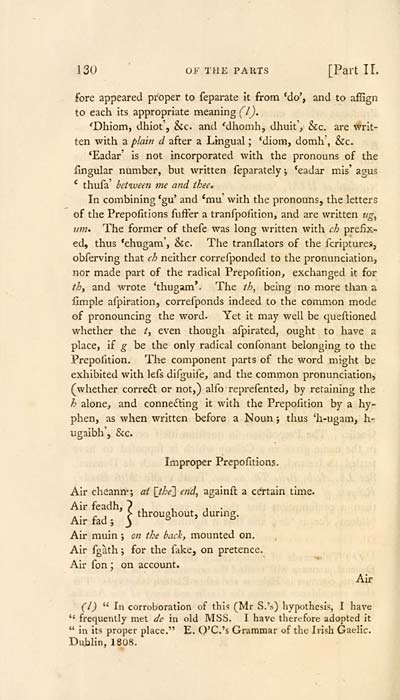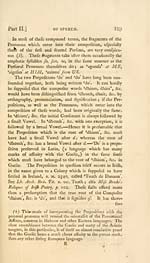Download files
Complete book:
Individual page:
Thumbnail gallery: Grid view | List view

130 OF THE PARTS [Part II.
fore appeared proper to feparate it from *do', and to affign
to each its appropriate meaning (I).
'Dhiom, dhiot'j &c. and 'dhomh, dhuit', &c. are writ-
ten with a plain d after a Lingual ; 'diom, domh", &c.
*Eadar' is not incorporated with the pronouns of the
lingular number, but written feparately \ *eadar mis' agus
' thufa between me and thee.
In combining 'gu' and 'mu' with the pronouns, the letters
of the Prepofitions fuffer a tranfpofition, and are written ug^
urn. The former of thefe was long written with ch prefix-
ed, thus 'chugam', &c. The tranflators of the fcriptures,
obferving that ch neither correfponded to the pronunciation,
nor made part of the radical Prepofition, exchanged it for
ihf and wrote 'thugam*. The th, being no more than a
fimple afpiration, correfponds indeed to the common mode
of pronouncing the word- Yet it may well be queftioned
whether the t, even though afpirated, ought to have a
place, if g be the only radical confonant belonging to the
Prepolltion. Tlie component parts of the word might be
exhibited with lefs difguife, and the common pronunciation,
(whether correal or not,) alfo reprefented, by retaining the
h alone, and connecting it with the Prepofition by a hy-
phen, as when written before a Noun } thus 'h-ugam, h-
ugaibh', &c.
Improper Prepofitions.
Air cheann*; at [the'] end, againfl a certain time.
Air feadh, 7 , i, ^ j •
Air fad; j throughout, durmg.
Air muin ; on the bach, mounted on.
Air fgàth ; for the fake, on pretence.
Air fon ; on account.
Air
(I) " In corroboration of this (Mr S.'s) hypothesis, I have
*' frequently met de in old MSS. I have therefore adopted it
" in its proper place." E. O'C.'s Grammar of the Irish Gaelic.
Dublin, 1808.
fore appeared proper to feparate it from *do', and to affign
to each its appropriate meaning (I).
'Dhiom, dhiot'j &c. and 'dhomh, dhuit', &c. are writ-
ten with a plain d after a Lingual ; 'diom, domh", &c.
*Eadar' is not incorporated with the pronouns of the
lingular number, but written feparately \ *eadar mis' agus
' thufa between me and thee.
In combining 'gu' and 'mu' with the pronouns, the letters
of the Prepofitions fuffer a tranfpofition, and are written ug^
urn. The former of thefe was long written with ch prefix-
ed, thus 'chugam', &c. The tranflators of the fcriptures,
obferving that ch neither correfponded to the pronunciation,
nor made part of the radical Prepofition, exchanged it for
ihf and wrote 'thugam*. The th, being no more than a
fimple afpiration, correfponds indeed to the common mode
of pronouncing the word- Yet it may well be queftioned
whether the t, even though afpirated, ought to have a
place, if g be the only radical confonant belonging to the
Prepolltion. Tlie component parts of the word might be
exhibited with lefs difguife, and the common pronunciation,
(whether correal or not,) alfo reprefented, by retaining the
h alone, and connecting it with the Prepofition by a hy-
phen, as when written before a Noun } thus 'h-ugam, h-
ugaibh', &c.
Improper Prepofitions.
Air cheann*; at [the'] end, againfl a certain time.
Air feadh, 7 , i, ^ j •
Air fad; j throughout, durmg.
Air muin ; on the bach, mounted on.
Air fgàth ; for the fake, on pretence.
Air fon ; on account.
Air
(I) " In corroboration of this (Mr S.'s) hypothesis, I have
*' frequently met de in old MSS. I have therefore adopted it
" in its proper place." E. O'C.'s Grammar of the Irish Gaelic.
Dublin, 1808.
Set display mode to: Large image | Transcription
Images and transcriptions on this page, including medium image downloads, may be used under the Creative Commons Attribution 4.0 International Licence unless otherwise stated. ![]()
| Early Gaelic Book Collections > Blair Collection > Elements of Gaelic grammar > (162) |
|---|
| Permanent URL | https://digital.nls.uk/79041919 |
|---|
| Description | A selection of books from a collection of more than 500 titles, mostly on religious and literary topics. Also includes some material dealing with other Celtic languages and societies. Collection created towards the end of the 19th century by Lady Evelyn Stewart Murray. |
|---|
| Description | Selected items from five 'Special and Named Printed Collections'. Includes books in Gaelic and other Celtic languages, works about the Gaels, their languages, literature, culture and history. |
|---|

